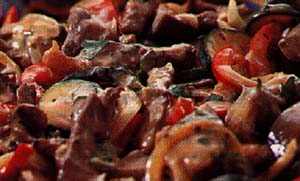|
|
Asian
Spicy Beef Curry

Ingredients:
2
tablespoons vegetable oil
1/2 lb (250 g) beef sirloin, cut into thin
slices
2 cups eggplant cubes
1 medium size unpeeled zucchini, sliced
1 fresh red pepper cut into thin strips
2 garlic cloves, minced or pressed
1 cup beef stock
1/2 cup coconut milk
1 teaspoon Thai red curry paste
1 tablespoon fresh basil, chopped
2 tablespoons fresh coriander, chopped
2 tablespoons lime juice
3 drops Tabasco sauce (or any hot pepper sauce)
Salt and ground white or black pepper to taste
Makes 4 servings.
Preparation:
- In a wok or large frying pan
heat 1 tablespoon vegetable
oil. Add beef and cook for about 2 minutes. With a slotted spoon remove
beef and set aside.
- Add remaining oil to the pan
and stir in vegetables and garlic.
Cook until slightly tender.
- In a medium size bowl mix
beef stock, basil, coconut milk
and Tabasco sauce. Set aside.
- Stir beef into the pan, add
coconut mixture, cover and simmer,
stirring occasionally for 15 to 20 minutes.
- Stir in lime juice and
coriander. Cook for 2 minutes and
serve hot.
Note: In Thai cuisine, curries are
meat, fish or vegetable dishes in a spiced sauce. They use local
ingredients such as chili peppers, Kaffir lime leaves, lemon grass,
Galangal and coconut milk, and tend to be more aromatic than Indian
curries as a result. Curries are often described by colour; red curries
use red chilis while green curries use green chilis. Yellow curries are
more similar to Indian curries, with their use of turmeric and cumin.
Yellow curries in Thailand usually don't contain potatoes except in
southern style cooking, however, Thai restaurants abroad usually have
them. Yellow curry is also called gaeng curry (by various spellings),
of which a word-for-word translation would be "soup curry" or "curry
curry". Some dishes have curry powder added.
|
|
Did You Know?
|
Curry
is a generic description used throughout European culture to describe a
general variety of spiced dishes, best known in South Asian cuisines,
especially Indian cuisine. Although there is no one specific attribute
that marks a dish as "curry", some distinctive spices used in many
curry dishes include turmeric, cumin, coriander, fenugreek, and red
pepper. The word curry is an anglicised version of the Tamil word khari
which is usually understood to mean "gravy" or "sauce" rather than
"spices". In Urdu, an official language of Pakistan and North India,
curry is usually referred to as saalan. In most South Indian cuisines,
a curry is considered a side-dish, which can be eaten along with a main
dish like rice or bread.
Curry's popularity in recent decades has spread outward from the Indian
subcontinent to figure prominently in international cuisine.
Consequently, each culture has adopted spices in its indigenous cooking
to suit its own unique tastes and cultural sensibilities. Curry can
therefore be called a pan-Asian or global phenomenon with immense
popularity in Thai, British, and Japanese cuisines.
In British cuisine, the word "curry" is primarily used to denote a
sauce-based dish flavoured with curry powder or a paste made from the
powder and oils. However, the use of fresh spices such as ginger and
garlic, and preparation of an initial masala from freshly ground dried
spices are sometimes used.
|
|